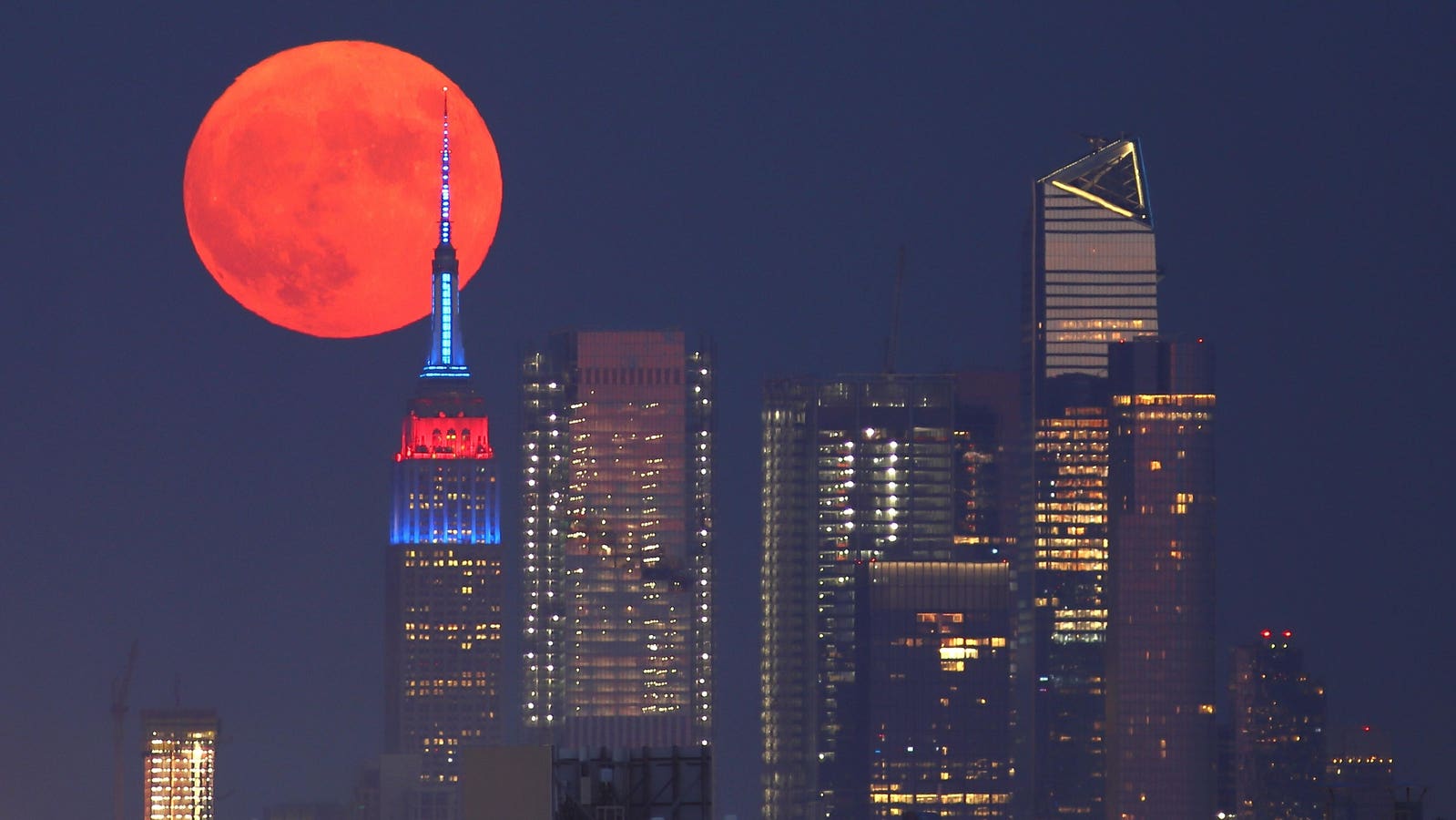Topline
The full buck moon — the first full moon of summer in the Northern Hemisphere — will turn full on Thursday, July 10. It will be best seen at moonrise as it appears in the east during dusk that evening. It takes its name from the antlers that emerge from a buck’s forehead in summer. Occurring so soon after the solstice, like last June’s strawberry moon, it will also be one of the lowest-hanging full moons of the year.
The full Buck Moon passes behind Hudson Yards and the Empire State Building in New York City on July … More
Key Facts
The buck moon will turn full at 4:38 p.m. EDT on Thursday, July 10. It will look full the night before and the night after it’s officially 100%-lit by the sun, but the best time to watch it rise will be at moonrise during dusk on Thursday, July 10.
EarthSky says July’s full moon is called the buck, thunder and hay moon in North America. Cultural and seasonal names for a full moon vary hugely across the world.
A full moon always looks at its best when it first appears on the eastern horizon during dusk. The sight is optimized when the moon rises shortly after sunset, which it does this month in North America, with the moon rising about 25 minutes after the sun goes down.
As well as rising late at night in the Northern Hemisphere, July’s buck moon is one of the lowest-hanging full moons of the year. That’s because the full moon is opposite the sun, by definition, so it mirrors the sun’s position — the full moon is at its lowest when the sun is at its highest. In practice, that means July’s full moon never gets very high in the sky.
To see the full buck moon at its best at moonrise, find an elevated location, an open field or an east-facing coastline with a clear view of the eastern horizon.
Best Time To See The Full ‘buck Moon’ Rise
To find the best time to see it appear from where you are, consult a moonrise calculator. Here are some sample times :
- New York: sunset at 8:29 p.m. EDT, moonrise at 8:54 p.m. EDT on Thursday, July 10.
- Los Angeles: sunset at 8:07 p.m. PDT, moonrise at 8:33 p.m. PDT on Thursday, July 10.
- London: sunset at 9:16 p.m. BST, moonrise at 9:46 p.m. BST on Thursday, July 10.
A view of the Apollo 11 lunar module Eagle as it returned from the surface of the moon to dock with … More
The Iconic Image Of All Humans But One, From The ‘buck Moon’
On July 21, 1969, the late Michael Collins — Command Module Pilot on NASA’s Apollo 11 spacecraft — took this image of the lunar lander Eagle as it returned Neil Armstrong, Apollo 11 Mission Commander, and Buzz Aldrin, Lunar Module Pilot, from the moon’s surface where they had become the first humans to walk upon it. In the background is Earth, making Collins the only human not featured. Technically speaking, those on Earth’s night side aren’t in it, either, but it remains an iconic image. Collins took it while he orbited about 60 miles (97 km) above the moon in Apollo 11’s Columbia command module, where he had remained alone for 22 hours.
Background
The buck moon is the seventh of 12 full moons in 2025. A solar year is 365.24 days, while a lunar year is around 354.37 days, so sometimes there are 13 full moons in one calendar (solar) year — as in 2023 and next in 2028. Of the 12 full moons in 2025, three will be “supermoons” and two “blood moon” total lunar eclipses (the first happened on March 13-14, and the next lunar eclipse is on Sept. 7-8).
The next full moon is the sturgeon moon, which will occur on Saturday, Aug. 9. It will be the second full moon of summer in the Northern Hemisphere and winter in the Southern Hemisphere.








